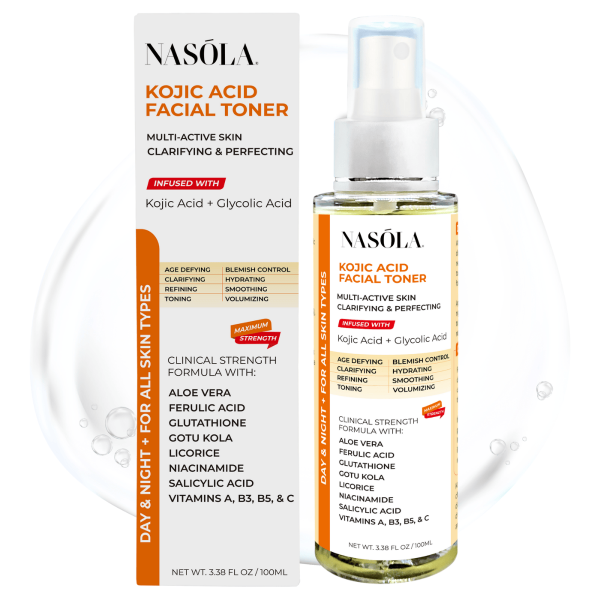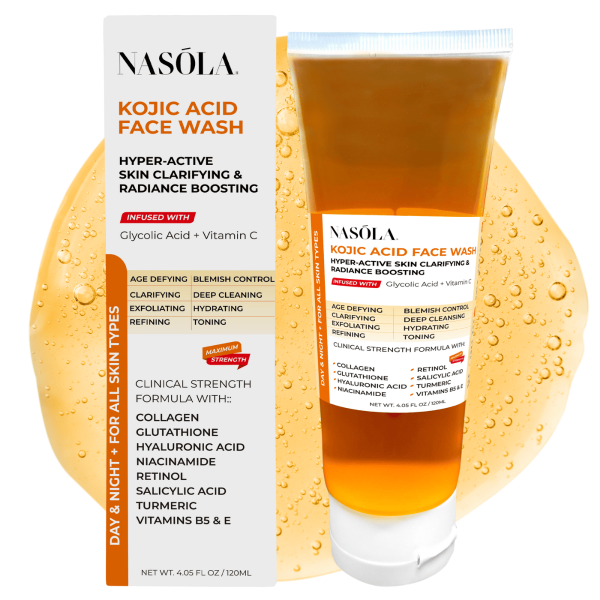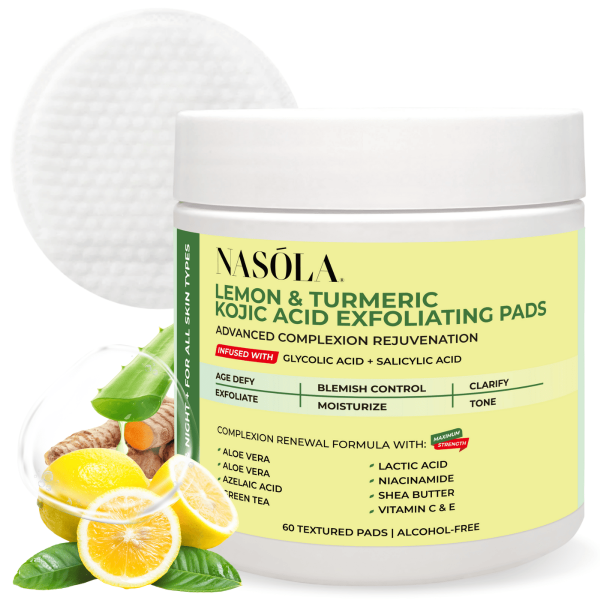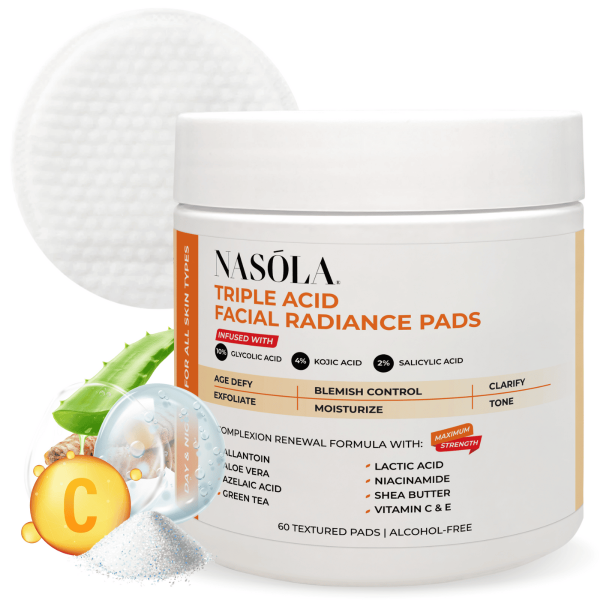If you’re confused about the difference between glycolic acid and salicylic acid, you are far from alone. These powerhouse exfoliants have undoubtedly earned their place in the skincare spotlight — yet they work in wildly different ways.
In this guide, you’ll learn how these two star ingredients show up for YOUR skin. From smoothing fine lines to unclogging stubborn pores, understanding which acid suits your skin type can finally lift the fog and turn your routine into a results-driven ritual.
And if you’re curious about how to ease into acids without going full-throttle? We’ll share a few gentle formulations like the Nasola Kojic Acid Facial Toner, Nasola Triple Acid Facial Radiance Pads, and Nasola Lemon Turmeric Kojic Acid Exfoliating Pads — because skincare shouldn’t require guesswork.
Let’s get into it…
- The Core Difference Between Glycolic Acid and Salicylic Acid
- Ingredient Spotlight: Kojic Acid for Skin Brightening
- When to Use Glycolic Acid vs Salicylic Acid in Your Skincare Routine
- Benefits of Using Products That Combine Multiple Acids
- How to Avoid Over-Exfoliation: Proper Usage Tips
- Bonus Section: Combining Glycolic and Salicylic Acid Safely
- Conclusion
- Frequently Asked Questions
The Core Difference Between Glycolic Acid and Salicylic Acid
The difference between glycolic acid and salicylic acid starts at the molecular level — and yes, that seemingly small detail can change everything when it comes to how they treat your skin.
Glycolic acid is a favorite among those with dry or textured skin thanks to its powers of surface exfoliation. Salicylic acid, on the other hand, gets deep, real fast, diving into pores to clear oil and congestion.
If you’re wrestling with dullness or fine lines, glycolic will likely be your thing. Fighting acne or blackheads? Salicylic is waving both hands in the air.
Let’s break it down:
What Is Glycolic Acid and How Does It Work?
Glycolic acid is an alpha-hydroxy acid (AHA), known for its incredible ability to exfoliate the top layers of the skin. It’s water-soluble, which means it doesn’t travel deep but sticks to surface-level issues like dull texture, uneven tone, or dry flakes.
Thanks to its small molecule size, glycolic acid penetrates quickly and efficiently, loosening the glue that holds dead skin cells together.
Benefits include:
- Surface smoothing for rough or bumpy skin
- Fades superficial hyperpigmentation and dark spots
- Encourages cellular turnover
- Diminishes the appearance of fine lines over time
What Is Salicylic Acid and How Does It Work?
Salicylic acid is a beta-hydroxy acid (BHA), and if you’ve ever battled acne, you’ve likely met this miracle ingredient.
Unlike glycolic acid, salicylic is oil-soluble — which means it can seep into pores and clear out all that trapped oil, dead skin, and gunk.
It’s also naturally anti-inflammatory, making it especially effective for angry, red breakouts or blackheads.
Top benefits of salicylic acid include:
- Deep pore cleansing to treat and prevent acne
- Reduces oiliness and shiny T-zones
- Soothes inflammation caused by blemishes
- Helps fade post-acne marks
Ingredient Spotlight: Kojic Acid for Skin Brightening
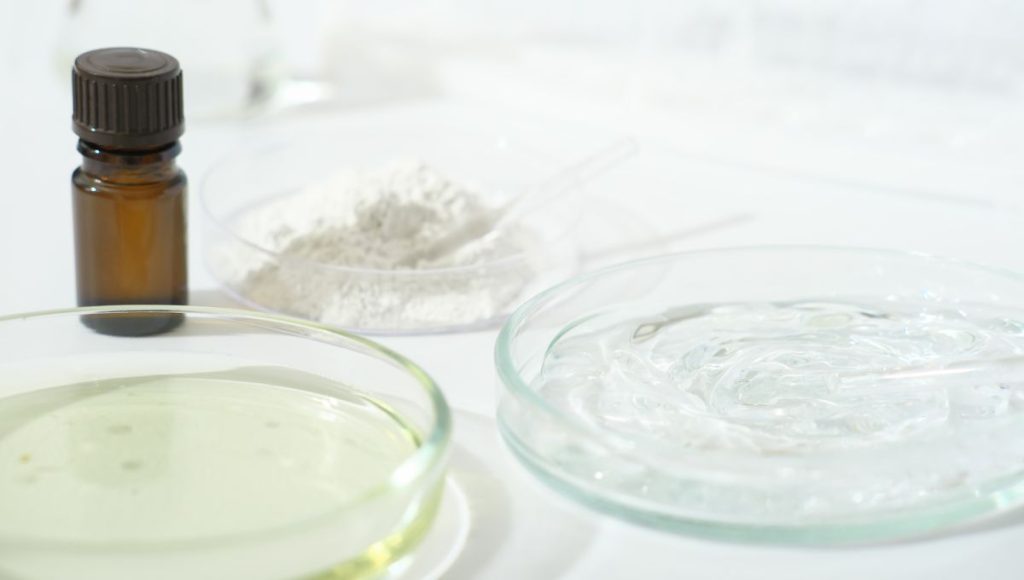
Kojic acid deserves its own standing ovation. Often paired with exfoliants, this natural brightener — derived from fermented rice — targets skin discoloration at the root: melanin production.
When paired with glycolic and salicylic acids, kojic acid elevates your glow game.
This combination is especially powerful for those struggling with melasma, sun spots, or dull skin.
What Is Kojic Acid and Why It Matters
Kojic acid works as a tyrosinase inhibitor — basically, it slows the production of melanin in your skin. That means fewer dark patches, more even tone, and a brighter overall complexion.
Some noteworthy advantages:
- Fades dark spots and acne scars
- Lightens sun damage and melasma patches
- Helps maintain results from exfoliation
- Works gently over time for all skin tones
Support your brightening journey with the Nasola Kojic Acid Facial Toner, which pairs kojic acid with calming botanicals that hydrate and balance post-exfoliation.
It’s one of my favorite layering steps for an even-toned canvas.
Pairing Kojic Acid With AHAs and BHAs
Because glycolic and salicylic acids help remove dead skin cells, using kojic acid after exfoliating creates the perfect environment for pigment correction. The fresher the skin, the more efficient kojic acid becomes.
And let’s not forget:
- Kojic acid complements chemical exfoliation without irritation
- Best used after acids for maximum absorption
- Enhances clarity and visibly reduces patchiness
- Safe to use daily in toner form like in Nasola’s blend
When to Use Glycolic Acid vs Salicylic Acid in Your Skincare Routine
So… when do you reach for glycolic and when do you go for salicylic acid? The difference between glycolic acid and salicylic acid becomes obvious once you consider your skin type, daily exposure, and goals.
It’s NOT one-size-fits-all — trust me, your skin knows the difference.
Let’s sort it out with a few angles:
Skin Type Matters
- Dry or combination skin? Glycolic acid is often the winner here. Its humectant properties aren’t talked about enough, and it can visibly soften surface roughness.
- Oily or acne-prone skin? Salicylic is the go-to. It’s a clarifying machine that reduces breakouts without over-stripping… when used correctly.
These general guidelines help:
- Use glycolic when managing texture or starting anti-aging rituals
- Choose salicylic when you’re dealing with oil, clogged pores, or hormonal acne
- Always monitor for sensitivity and adjust frequency accordingly
Time of Day & Frequency
Start slowly. Like, slower than slow. Your skin barrier will thank you.
- Use once every 2–3 days and build tolerance
- Avoid mixing both acids daily if your skin is new to chemical exfoliants
- Apply at night to avoid increased sunlight sensitivity
- Follow up with calmers… especially something hydrating and soothing
The Nasola Lemon Turmeric Kojic Acid Exfoliating Pads are a great pick for newcomers — combining brightening kojic acid, calming turmeric, and mild exfoliants in easy-to-use pads. No guesswork, no drama.
Benefits of Using Products That Combine Multiple Acids
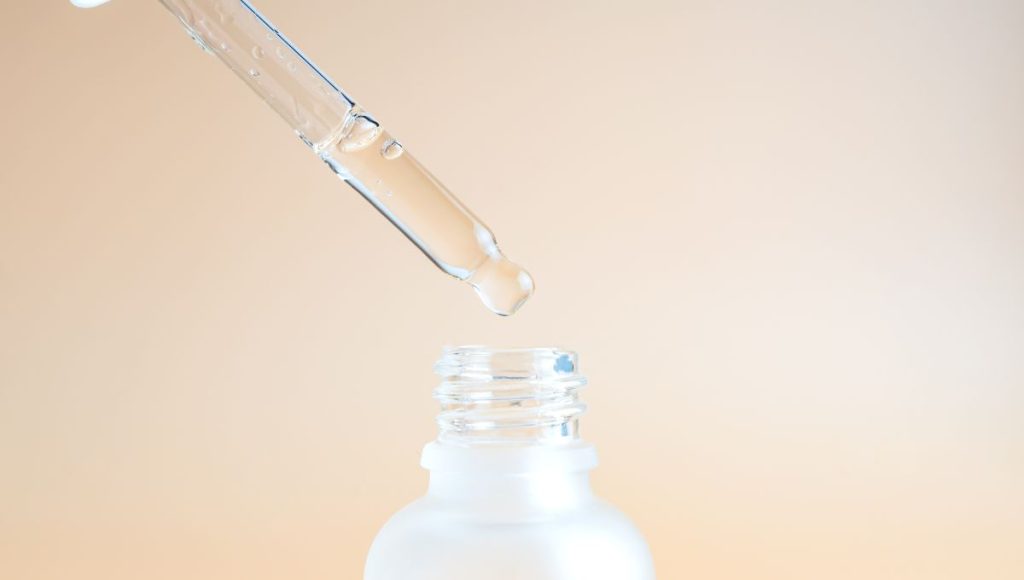
When used correctly, glycolic and salicylic acids together are skincare sorcery. The difference between glycolic acid and salicylic acid becomes synergistic — surface renewal meets pore-deep cleansing.
This is where combo formulations come to shine bright (and smooth).
But don’t just go layering acids randomly…
Enhanced Exfoliation With AHA + BHA Combos
Formulas that fuse both acids correctly can:
- Unclog pores while lifting dullness on the surface
- Smooth out texture AND prevent new breakouts
- Enhance absorption of serums and moisturizers
- Improve glow with reduced congestion and flakiness
Products like the Nasola Triple Acid Facial Radiance Pads are engineered with a smart cocktail of glycolic, salicylic, and lactic acid — plus kojic acid. I call it a 4-in-1 facelift for your pores.
Kojic Acid + Exfoliants = Bright and Clear Skin
Layering kojic acid with multi-acid pads is ideal if you’re targeting:
- Acne scars or dark post-inflammatory marks
- Melasma triggered by heat or hormones
- Fine lines and tone issues due to sun damage
- Rough texture from buildup or large pores
Try sandwiching your acids with a calm cleanser like the Nasola Kojic Acid Face Wash for best results.
How to Avoid Over-Exfoliation: Proper Usage Tips
We all love quick results. But skin doesn’t speed-run. 🙃 Overdoing acids can ruin your progress — or worse, damage your barrier. Whether you’re using glycolic or salicylic acid, moderation saves the day. And that’s coming from someone who learned the hard way. Twice.
Signs You’re Overdoing It
Be real with your skin. If you see any of the following:
- Stinging that lasts longer than a few seconds
- Unexpected dry patches or flakes
- A burning tightness that doesn’t fade
- Increased breakouts (especially cystic or red bumps)
Then you’ve gone too far…
How to Protect and Recover Your Skin
Here’s your rescue mission:
- Pause exfoliating immediately
- Rebuild with deep hydration (think ceramides, hyaluronic acid)
- Always apply SPF daily (religiously)
- Go gentle — use a pH-balanced cleanser like the Nasola Kojic Acid Face Wash to keep things calm yet clean
Bonus Section: Combining Glycolic and Salicylic Acid Safely
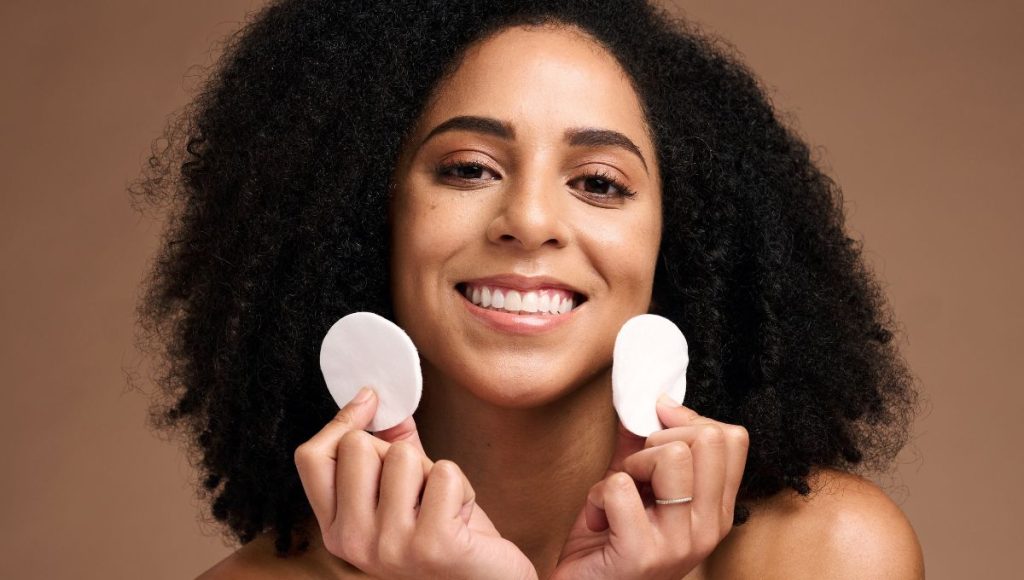
Yes, the difference between glycolic acid and salicylic acid doesn’t mean you must pick a side. You CAN use both — if they’re formulated properly. This is where ingredient synergy shines.
The Nasola Triple Acid Facial Radiance Pads are a perfect example. Balanced, buffered, and boosted with antioxidants + kojic acid — they give you transformation without trauma.
Are They Safe to Use Together?
General rule:
- Pre-formulated products that optimize pH and ratios = safe
- Freestyling mixtures = riskier
- Patch test always
- Never mix if you’re already using prescription actives
Best Practice in Layering Acids
To keep your skin barrier intact:
- Use acid blends no more than 2–3 times per week
- Apply on dry skin and follow with a non-fragranced moisturizer
- Avoid mixing with retinol or Vitamin C in the same routine
- Introduce one new acid at a time for clarity
Conclusion
So here’s the real tea: the difference between glycolic acid and salicylic acid lies in where they work and what they solve. One buffs from the outside (glycolic), the other unclogs from deep inside (salicylic).
More importantly, your skin type matters.
With thoughtful use of multi-acid blends like the Nasola Triple Acid Facial Radiance Pads, you’ll unlock brighter, clearer skin, without the irritation guessing game.
And if you’re just dipping your toes into chemical exfoliants, I cannot recommend the Nasola Kojic Acid Facial Toner enough — it’s hydrating, enlightening, and beginner-friendly.
Start slow, stay consistent, and let your glow speak for itself.
Frequently Asked Questions
Glycolic acid exfoliates the skin’s surface, improving texture and tone. Salicylic acid goes deeper into pores to dissolve oil and address acne. Their mechanisms are different, making them ideal for different skin concerns.
Yes, but only in balanced products like the Nasola Triple Acid Facial Radiance Pads. They’re formulated to provide results without irritation, making combo use safe and effective.
Use both. Salicylic prevents breakouts and fades spots. Glycolic smooths texture and boosts cell turnover. Add Nasola Kojic Acid Facial Toner to brighten post-acne marks for best results.
Start with 2–3 times per week. Watch how your skin reacts and increase gradually if needed. Always follow with sunscreen, as acids make your skin more UV-sensitive.
Yes. The Nasola Lemon Turmeric Kojic Acid Exfoliating Pads are formulated with turmeric and kojic acid, offering gentle exfoliation without compromising sensitive skin.
Glycolic acid in particular helps smooth fine lines and improve texture. When used consistently, it boosts collagen and creates a plumper, refreshed appearance over time.
Avoid layering acids with retinoids or pure Vitamin C unless directed. Also skip harsh scrubs or exfoliating brushes while using chemical exfoliants.
Start with the Nasola Kojic Acid Facial Toner for a gentle introduction to kojic acid and daily brightening without irritation.
Yes!! Acids increase sun sensitivity, and UV damage can reverse all your progress. Reliable daily SPF is non-negotiable. Period.
If they’re part of a pre-formulated product like Nasola Triple Acid Facial Radiance Pads, then yes. Otherwise, alternate them on different days to avoid irritation.


